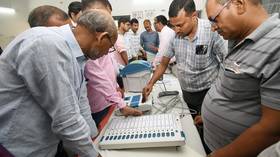India’s top court defends use of voting machines

India’s Supreme Court has cautioned against claims that the electronic voting machines (EVMs) used in the country’s general election, which began on Friday, are unreliable, adding that they are not inferior to those used in Europe.
The court has been hearing a number of petitions seeking 100% cross-verification of votes cast on EVMs with paper slips. The petitioners also suggested tweaking the current system – including the use of paper ballots, citing examples from European countries.
On Thursday, a day before the first phase of voting kicked off, the court reserved judgment in the case, noting that rising voter turnout is an indicator of the “people’s faith” in the electoral process.
Responding to comparisons drawn by the petitioners between foreign countries and India, Sanjiv Khanna, one of the justices presiding over the case, said, “We have our own system. It’s working well.” The court added that elections in India are a “humongous task,” given the size of the electorate. Nearly 970 million people are eligible to vote – more than Europe’s total population.
In the run-up to the election, opposition parties questioned the accuracy of the electronic voting system, with many suggesting that anything with a chip installed can be tampered with. India’s Election Commission has dismissed the allegations.
SHOCKING 😳😱Forget EVM hacking, this is neurological hacking .. A voter was about to vote for Congress button but their body muscles stoped responding and their finger programming was changed and forced to press the BJP button on EVM machine !! Watch pic.twitter.com/W4XC7SOpvn
— Yo Yo Funny Singh (@moronhumor) April 19, 2024
Rahul Gandhi, the de facto leader of the opposition Congress Party, has called the election, which will run until June 1, “a fixed match,” and claimed that the ruling Bharatiya Janata Party (BJP) cannot win without the use of EVMs. The BJP has dismissed these claims, saying the Congress Party is calling the machines into question as an excuse for its presumed electoral losses.
An Election Commission representative told the court that it is not possible to tamper with the machines “at any stage,” The Hindu reported. Election officers press a ‘close’ button on a control unit attached to the machine at the end of the polling, after which the machines cannot accept more votes, according to the outlet.
The machines completely replaced paper ballots in the 2004 Lok Sabha elections across all 543 parliamentary constituencies. To cast a vote with an EVM, a button next to the candidate’s name or party symbol on a screen is selected.
Losing parties in India have often blamed election results on EVMs. When the BJP lost an election to the Congress-led United Progressive Alliance (UPA) in the past, it attributed the loss to “EVM fraud.”
Where India Meets Russia – We are now on WhatsApp! Follow and share RT India in English and in Hindi













